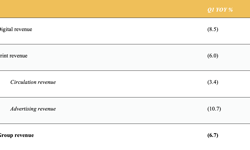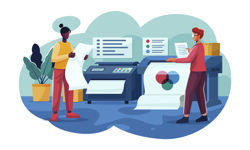The report is entitled Entitled European Digital Media Landscape to 2020 and its authors Martin Glass of EMGE & Co and Jim Bilton of Wessenden Marketing presented a summary of the report at Monday’s official launch. They were then joined by Scott Barclay of PaperlinX, Ian Allan of Polestar and Mark Wood of Future Publishing to form a panel to provide comment and generate discussion. Peter Day the BBC Business Correspondent was in the chair.
According to the Stationers’ Company: We are living in a “digital whirlpool”, a phase when competing digital and paper-based technologies are creating complex media migrations and where the rise of the mobile, tablet and cloud based storage and “big data” information banks are changing the battle lines. Digital and paper based technologies continue to vie for the marketers’ attention as we move from a “print-first” to “digital-first” setting.
This follows the similarly named report five years ago which at the time was regarded as unnecessarily gloomy in its forecasts but which turned out to be realistic as digital alternatives to print combined with an economic maelstrom to rock the printing and paper industries.
Since that last report the EU has established “A Digital Agenda for Europe”, a policy to promote and develop all aspects of the digital economy.
Most households today have multiple hardware (PCs, laptops, smartphones, tables, TVs, gaming consoles DVD players etc) and the generation of digital natives born after 1995 has risen from 15% at the time of the first report to 28% today but also in the intervening five years every age group has become more digital. Today 30% of Internet browsing is from mobile phones and tablets and 65% of the population have social media accounts. There is an increase in purchasing online and WiFi/3G has almost become a “basic human need” with most smartphone users keeping their devices close to hand throughout the day. At the same time data on individuals is being collected at an unprecedented rate, allowing marketing to become more targeted.
Today the edges between technologies are blurring and there are digital players going back to print and print publishers going digital and others launching on multimedia platforms. There are digital technologies and applications that are with us long term, others that will turn out to be hype. The authors believe that by 2020 most of the substitution effects between digital and print will have taken place and the paper and print industries, whilst reduced, will reach a settle-down phase in a world dominated by digital, when the durability of print will be recognized. The authors offered eight challenges to the paper and print sector:
* Embrace digital, don’t fight it. It is your friend not your enemy
* Know more about digital than digital knows about print
* Be more creative with print applications. Think outside the box and adopt new technologies like augmented reality, optical recognition, goggles etc
* Be confident and honest about papers’ qualities, its engagement capability when digital technology increasingly fragments data to meet the needs of the smaller devices
* Match content to the medium
* Aim for value rather than volume – print offers a deeper experience than digital can offer
* Develop the metrics to prove that print engagement, something to compare to and compete with the volume metrics of digital
* Make yourselves relevant in a digital world
In addition to a look at overall trends, paper volumes etc the European Digital Media Landscape to 2020 report includes a look at specific market segments, including newspapers, magazines, books, advertising and commercial print and office/business documents.
The Report can be purchased for £950 (or £2,500 for multiple use up to ten) from the Stationers’ Company.
The Report gives hope that paper-based media has a future alongside other digital alternatives and that there remains a need to be adaptable and creative to secure a place in the journey from the print-first to digital-first world.
Ian Locks, newly appointed Master of the Stationers’ Company, says: “We are very proud to be able to publish this report, evidence that the Company remains the think tank for the Content and Communications sector. The company has been in existence for over 600 years but now it is playing an even more vital role in bringing all those in the paper-based communications supply chain together to discuss and address issues and build a strong future in a digital world.”










